Podcast
Questions and Answers
What is the phenomenon that occurs when charges accumulate on an object overpowering the dielectric strength of the insulator, leading to an electrical breakdown?
What is the phenomenon that occurs when charges accumulate on an object overpowering the dielectric strength of the insulator, leading to an electrical breakdown?
- Corona Discharge
- Sparks
- Electrical Shock
- Triboelectric Flashover (correct)
Which measure involves connecting an insulating material to earth potential to provide a path for static charges to safely dissipate?
Which measure involves connecting an insulating material to earth potential to provide a path for static charges to safely dissipate?
- Clothing Materials
- Ionization
- Grounding (correct)
- Conductive Coatings
What effect of static electricity can be observed as bright flashes of light during a sudden release of static electricity?
What effect of static electricity can be observed as bright flashes of light during a sudden release of static electricity?
- Corona Discharge
- Damage to Electronic Devices
- Electrical Shock
- Sparks (correct)
Which antistatic measure involves using coatings made from metals like aluminum or copper to reduce static buildup?
Which antistatic measure involves using coatings made from metals like aluminum or copper to reduce static buildup?
What type of discharge occurs when there is a significant difference in charge between two objects causing an arc-like discharge?
What type of discharge occurs when there is a significant difference in charge between two objects causing an arc-like discharge?
What happens when electrons flow from your body to the ground as you walk on a rug?
What happens when electrons flow from your body to the ground as you walk on a rug?
What is the primary effect of static electricity that can cause sparks capable of igniting flammable gases or vapors?
What is the primary effect of static electricity that can cause sparks capable of igniting flammable gases or vapors?
Which antistatic measure involves using materials with a lower tendency to generate static electricity, such as wool, silk, silver, and brass?
Which antistatic measure involves using materials with a lower tendency to generate static electricity, such as wool, silk, silver, and brass?
What is the purpose of connecting objects to the ground as an antistatic measure?
What is the purpose of connecting objects to the ground as an antistatic measure?
What is one of the biological effects of static electricity on living organisms such as humans?
What is one of the biological effects of static electricity on living organisms such as humans?
Flashcards are hidden until you start studying
Study Notes
Static electricity is a common phenomenon observed when there is an imbalance of electric charges within or on the surface of a material, resulting from contact between materials with different electrical properties. It manifests in simple situations like walking across carpeted floors or sliding out of chairs during cold weather. This article explores the generation of static electricity, its relationship with friction, the phenomenon of electrostatic discharge, and the measures taken to prevent its negative effects.
Generation of Static Electricity
Static electricity is generated through a few primary mechanisms: triboelectric effect, electrification by induction, and electrification by conduction. In most instances, it arises due to the triboelectric effect, which occurs when two different materials come into contact and separate, causing a buildup of charge on their respective surfaces. For example, rubbing balloons against hair can generate static electricity.
Friction's Role
Friction plays a crucial role in generating static electricity. When two materials rub against each other, they transfer electrons back and forth until one material accumulates a surplus of electrons and becomes negatively charged, while the other develops a deficit of electrons and becomes positively charged. The extent to which this charge separation occurs depends on the relative permittivities of the materials involved.
Electrostatic Discharge
Electrostatic discharge (ESD) is the rapid release of static electricity from an object or a person. ESD can discharge in various ways, such as:
- Direct Discharge: Occurs when the difference in charge between two objects is so great that the voltage gap is bridged, leading to an arc-like discharge.
- Corona Discharge: Resulting from a gaseous medium, corona discharge occurs when the gap between an object and a grounded surface is too large for direct discharge, but still small enough for the electric field to ionize the air.
- Triboelectric Flashover: This occurs when charges accumulate on an object until the electric field strength overpowers the dielectric strength of the insulator, causing an electrical breakdown.
ESD can have various effects, including:
- Sparks: Bright flashes of light that can be seen when there is a sudden release of static electricity.
- Electrical Shock: High levels of static electricity can cause electrical shocks to people if they come into contact with conductive objects.
- Damage to Electronic Devices: Static electricity can damage sensitive electronic devices due to voltage surges.
Antistatic Measures
To mitigate the negative effects of static electricity, various measures have been developed:
Grounding
Grounding involves connecting one end of an insulating material to earth potential, thereby providing a path for static charges to dissipate safely. This technique reduces the likelihood of static electricity building up on the grounded object and minimizes the risk of electrostatic discharge.
Ionization
Ionization techniques generate charged particles that neutralize static charges by attracting and bonding with oppositely charged electrons. These methods include corona discharge ionizers, air ionizers, and plasma technology.
Conductive Coatings
Conductive coatings made from metals like aluminum or copper can reduce static buildup by allowing electric charge to flow through the coated surface. Examples include static-dissipative mats used in electronics manufacturing.
Clothing Materials
Some clothing materials, such as those containing lycra or polyester, help dissipate static electricity by conducting away excess charges when exposed to humidity.
Static electricity is a fascinating and often unnoticed part of our daily lives. Understanding its generation, the role of friction, electrostatic discharge, and antistatic measures helps us appreciate the importance of maintaining safe environments where static electricity could pose serious risks.
Studying That Suits You
Use AI to generate personalized quizzes and flashcards to suit your learning preferences.




